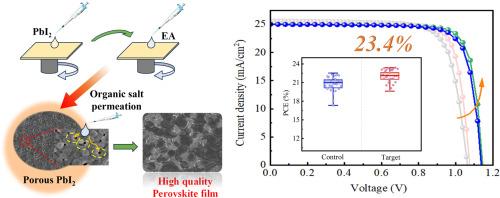绿色溶剂诱导多孔碘化铅在两步法钙钛矿太阳能电池中的关键作用
IF 5.7
3区 材料科学
Q2 MATERIALS SCIENCE, MULTIDISCIPLINARY
引用次数: 0
摘要
通过两步法制备高效稳定的钙钛矿太阳能电池(PSCs)仍然具有挑战性,主要是由于有害的PbI2残留和不完全的钙钛矿形成。为了克服这一关键限制,我们开发了一种创新的乙酸乙酯(EA)处理方法,直接应用于PbI2层。这一有针对性的步骤可以有效地诱导多孔PbI2层的形成,显著增强后续FA+/MA+离子的穿透,促进钙钛矿的完全转化,从而获得缺陷密度显著降低的高质量FAMAPbI3膜。优化后的PSCs实现了23.42%的功率转换效率(PCE),并且在未封装条件下表现出出色的湿度稳定性,在528 h后保持了90%以上的初始效率。这项工作为内在缺陷控制提供了一种新的策略,显著推进了高效和稳健的PSCs的发展。本文章由计算机程序翻译,如有差异,请以英文原文为准。

The critical role of porous lead iodide induced by a green solvent in two-step processed perovskite solar cells
Fabricating highly efficient and stable perovskite solar cells (PSCs) via two-step method remains challenging, primarily due to detrimental PbI2 residues and incomplete perovskite formation. To overcome this critical limitation, we developed an innovative ethyl acetate (EA) treatment applied directly to the PbI2 layer. This targeted step can effectively induce the formation of a porous PbI2 layer, dramatically enhancing subsequent FA+/MA+ ion penetration and promoting complete perovskite conversion, thus resulting in high quality FAMAPbI3 films with significantly lowered defect density. The optimized PSCs achieved a compelling power conversion efficiency (PCE) of 23.42 %, and demonstrated excellent humidity stability under unencapsulated conditions, retaining over 90 % of its initial efficiency after 528 h. This work offers a novel strategy for intrinsic defect control, significantly advancing the development of highly efficient and robust PSCs.
求助全文
通过发布文献求助,成功后即可免费获取论文全文。
去求助
来源期刊

Materials Research Bulletin
工程技术-材料科学:综合
CiteScore
9.80
自引率
5.60%
发文量
372
审稿时长
42 days
期刊介绍:
Materials Research Bulletin is an international journal reporting high-impact research on processing-structure-property relationships in functional materials and nanomaterials with interesting electronic, magnetic, optical, thermal, mechanical or catalytic properties. Papers purely on thermodynamics or theoretical calculations (e.g., density functional theory) do not fall within the scope of the journal unless they also demonstrate a clear link to physical properties. Topics covered include functional materials (e.g., dielectrics, pyroelectrics, piezoelectrics, ferroelectrics, relaxors, thermoelectrics, etc.); electrochemistry and solid-state ionics (e.g., photovoltaics, batteries, sensors, and fuel cells); nanomaterials, graphene, and nanocomposites; luminescence and photocatalysis; crystal-structure and defect-structure analysis; novel electronics; non-crystalline solids; flexible electronics; protein-material interactions; and polymeric ion-exchange membranes.
 求助内容:
求助内容: 应助结果提醒方式:
应助结果提醒方式:


